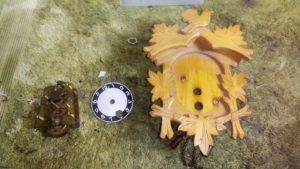This is not a long article [Edit Note: It turned out to be much longer once I got going] and in fact its technically completely inaccurate because its not a cuckoo clock. I wanted it it to be one. I really did, because in all its no more than 5 cm across which really would qualify it as the smallest cuckoo we have repaired. The other small problem in defining it as a cuckoo clock is that there is a complete abscence of cuckoo. Never mind, its a great excuse to bang on about cuckoo clocks which is basically a leisure activity as far as I am concerned.

I’m going to dive off into how cuckoo clocks are driven and fundamentally function.
We are at “small clocks” so lets start there. I just had to double check the spelling of “clock” after the “bracket c*ck” printing typo fiasco; click here to read about that later if you want a laugh at my expense (you are welcome).
Anyway, some of the small cuckoo clocks we work on are a miracle of construction when you see what they fit into such a small space. It makes them a little more complicated to work on because with that compaction, comes decreased tolerances in what can move around and how far. Levers and activating wires have less room and length to travel so configuration must be that much more precise. With larger clocks the challenges are different and tend to be the distribution of power to the automata.
The small clock I started with in this article, while not a cuckoo clock, did have some cuckoo styling in the way the gear train was organised. Its actually quite a good place to start when describing the design traits of a cuckoo clock movement. Even this little one had that donkeys kick you get from cuckoo movement when they are properly serviced. A real thwack on each pallet strike!
Pallets on a cuckoo tend to be robust single strip construction. This marries to an escapement cog that is aggressively cut for a long hard and prolonged leverage contact on each pendulum push. This results in all the force from the weight/gear train really getting behind each escapement cog to pallet contact that makes the tick – tock sound we are familiar with.
A clock made in this way needs power on tap. A good mechanical analogue would be a big V8 car engine. Its not particularly elegantly designed but its thirsty on power/fuel and really gets the job done while looking and sounding fantastic.
This power requirement is why so many cuckoo clocks are one day machines. “Why should this make a difference?” you might ask yourself. Well, its about force multiplied by time (or the drop distance of the weight in this case).
To demonstrate how much more power you get from a one day weight system, compare it to a spring driven system on a mantle clock. If you took the spring out of that 8 day clock and gave it enough wind for one day it would have one days power stored in it. Its not much – a couple of full key turns. Much less that the amount of power to lift a quarter of a kilo or more up by 1 meter, which is the energy stored in each cuckoo weight each time you raise it.
A spring may look and feel like the more powerful system but its not by a long way. Even a 30 hour clock spring would struggle to store the energy required to get a cuckoo weight raised half the distance up for a days operation. So the cuckoo movement is powerful and rightly so!.
As Ive discussed, the cuckooo movements are geared and designed to take advantage of this extra power and they use it for, among other things, pushing activating wires, shoving birds out of doors and getting water wheels turning.
I’ve mentioned activating wires which are important to understand when understanding how the power shifts around the clock and creates that wonderful chain of events you get with a cuckoo clock.
These are wires within the clock that literally stick out like arms and press down levers on completely separate systems, such as the music box, to set them off. These “domino”chain events that are independently driven by the other two weights so each operation has exclusive force applied to it by its weight in sequence. Next time you look at your cuckoo clock chirping away, look at the weights. You can see each weight take control of its process stage by stage.
One weight drives the cuckoo and bellows, the other the music box and automata, and between them both, the centre weight drives the hands and pendulum. And you really need all that power to drive all the beer drinkers, hens, saws water wheels, and the other day even a band saw on one this week.
So, in summary, all the noise and showmanship of the clock requires three good high torque power plants regulated and conducted by the movement like a conductor waving his baton at the music box, cuckoo and bellows. Thats what the heavy fast dropping pine cones are all about.
A good punch of torque which makes the triggering sharp is characteristic of a good healthy cuckoo clock and something you should pay attention to when looking to buy one second hand. Even the 19th century Victorian clocks we frequently work on have that assertive sharp operation when they are working properly. The cuckoo should belt out and the door almost rattle on a properly maintained clock. Its a joy to watch.
I dread to think how much time I have spent just watching a wooden bird emerge from a small door in an entirely predictable fashion. Having said that, it always takes the observer by surprise for some reason in a way that other chiming clocks don’t.
The other thing about this, oddly, is that you know roughly what time it is in the house pretty much all the time. Other types of clock such as gong or bar chiming clocks are rather gentle, even if they are loud. Consequently you stop hearing it in the same way as you stop hearing trains if you live next to a railway line. With a cuckoo you just tend to hear the first chirp, and from then on your counting subconsciously wether you like it or not.
I should have been a cuckoo clock salesman.
If I was going to do that, I’d want to sell the Loetschers. I dont have time to actually sell clocks so its a moot point, but I have to say I really like the attention to detail and classic Swiss look of the Loetscher clocks. Of course its down to what you like at the end of the day and there are plenty of styles to choose from but Loetscher are well worth considering.
Mechanically they are brilliant. I was chatting to my friends Loetscher about how many actually go wrong. I asked only because we simply don’t get any warranty repair work and I was wondering how this could be the case with so many clocks sold. Loetscher have been around a long time so there are the vintage clocks to be serviced, however, we only see clocks produced in the last ten years if they have been accidentally damaged, or abused by children playing Tarzan of the Clocks on your £1800 3 weight (happens all the time). Everything is well made on the clocks, even the hands, and they dont seem to go wrong.
So, I asked how many clocks actually came back to the factory due to manufacturing error. It was a ridiculously low figure which Im probably not at liberty to state, however, its the sort of figure you only need one hand to count. From thousands of clocks. That, to me at least, sounds like the sort of component survival rate associated with medical or aerospace.
I don’t sell clocks or spares but if your a Loetscher customer and you need replacement hands then send me a picture of the back and front of the clock. I can send you some hands which we normally provide compliments of Loetscher.
[Edit Note: Ive just re-read this and it comes over a bit “Loetscher heavy”, when it was supposed to be a bit more generic I suppose. This not a selling blog and never will be. I don’t like selling and I dont think other people do either on whichever side of the table your sitting.
I write the blog create more “awsome” and less “suck” in the world for people who are into clocks and mechanics. As far as the Loetscher comments go, they make good clocks. Also I do get on particularly well with them and they are really helpful and care a lot about their customers – genuinely, they take it personally. This makes my job so much easier when we need help with identification or an old model or a lightning fast parts delivery from Switzerland. If thats what I think, and I should know, then I’m going to tell you so you know too. Thats what its all about on this blog, and providing its on subject, I think a nudge in the right direction on consumer advice is ok.]

Recent Comments